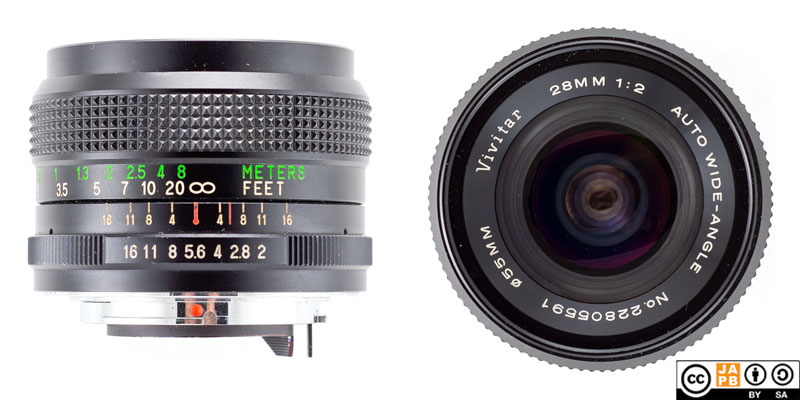Pekka Buttler, 03/2024

Specifications
The table below summarizes the lens’ key specifications (measurements based on pictured, last version of the lens):
| Brand: | Vivitar | Lens name | 28MM 1:2 auto wide-angle |
| Focal length(s)1 | 28 mm | Angle-of-view2 | 75,4° |
| Maximum Aperture | f/2 | In Production | 1978–1983 |
| Lens mount (this lens) | Pentax K | Other lens mounts | multiple3 |
| Length4 | 45,2 mm | Diameter54 | 63,7 mm |
| Filter ring diameter | 55 mm | Weight | 258 grams |
| Lens element count | 8 | Lens group count | 8 |
| Aperture blades (S/R/C)6 | 6 S | Focus throw | 225 ° |
| Minimum focusing distance | 30 cms | Maximum magnification | 1:7,5 |
| Has manual aperture ring | YES | Has Manual focus ring | YES |
| Aperture mechanism type | Automatic | Aperture click stops 7 | 2•2.8•4•5.6•8•11-16 |
Further notes:
• There are two different lenses that Vivitar sold that shared the same mainline specifications, namely a 28 mm focal length and an f/2 maximum aperture. This, earlier lens was designed and manufactured by Kino Precision (also known as Kiron) and carries the ’22’ serial number prefix. Starting in 1983 Komine (serial number prefix ’28’) also manufactured a 28 mm f/2 lens for Vivitar that sports a 49 mm filter thread and a shorter minimum focusing distance.
• The Kiron MC 28 mm f/2 lens is fundamentally the same lens as this lens, albeit in a cosmetically somewhat different package.
Versions and variations
Besides having a distant cousin in the Kiron MC 28 mm f/2, this Vivitar 28 mm f/2 was manufactured for a broad range of lens mounts, which in itself leads to some variation (with the difference in flange focal differences ranging from 40,5 mm to 46,5 mm). Hence the length of the Vivitar 28 mm f/2 will vary significantly based on which lens mount it has.
Interestingly, Kino precision seems to have taken the approach to use the added length of some lenses (due to FFD-variation) to enable a broader focusing ring. This can clearly be seen in that while the focus ring pattern (rubber, diamonds) is uniform, some lenses offer a ribber grip that is five rows of diamonds wide (such as the pictured M42 lens) while some lenses offered up to 8 rows of diamonds (specifically, the Konica AR version).
Similarly, some lenses will be all-black (such as the pictured lens, in M42 mount), some lenses will have a narrow silver band at the mount-end and some will have a broader silver ring .
It would seem that Kino precision did a minor update to the lens in 1980 (serial numbers starting 220–222) at which stage the abbreviation ‘MC’ was added to the name ring and the name ring typography changed a bit. However, as the Kiron MC 28 mm f/2 was multicoated from the beginning, it is more likely that the addition of ‘MC’ to the Vivitar version’s name ring is purely marketing-related than an indicator of a substantial change to the coatings used.
Similarly, there is nothing to indicate that any of these cosmetic variations would correspond to any changes in the optical recipe used in the different lenses.
History of Vivitar
Vivitar initially was the trade name used by Ponder & Best Inc. until Ponder & Best changed its name to Vivitar Corp. From the 1960s to the early 2000s the company contracted various (mostly Japanese) optical and electronics manufacturers to manufacture photographic gear to be branded as Vivitar.
You can read more details in the Vivitar company profile.
Adapting
n.B! The following applies to all non-electronic Pentax K mount lenses.
If you want to natively mount this lens you need to find a functioning Pentax K mount SLR (or a dSLR) camera. Luckily that should be relatively easy as Pentax K film bodies were produced in their millions and most of them – especially those manufactured by Pentax – have a good reliability record. Alternatively, you can use this lens natively on any Pentax dSLR.
Adapting this lens to a mirrorless, full-frame digital camera is a breeze thanks to the lens having full manual controls (aperture ring, focus ring). You simply need a dumb adapter from Pentax K to your mirrorless system.
Due to the medium flange focal distance used by the m42 mount (45,46 mm), whether you can adapt this lens to other than Pentax’ dSLR mounts depends on which dSLR mount: Canon EF, and Four Thirds can mount Pentax K lenses using a simple adapter ring. Minolta/Sony A and Nikon F on the other hand are not as problem-free, and – to retain anything near infinity focus – the adapter will necessitate corrective optics. In all cases, your camera will work only in stop-down metering.
Footnotes
- Focal length is (unless stated otherwise) given in absolute terms, and not in Full-frame equivalent. For an understanding of whether the lens is wide/tele, see ‘Angle-of-view’. ↩︎
- Picture angle is given in degrees (based on manufacturers’ specs) and concerns the diagonal picture angle. Rule of thumb:
> 90 ° ==> Ultra-wide-angle
70–90 ° ==> Wide-angle
50–70 ° ==> Moderate wide-angle
40–50 ° ==> ‘Standard’ or ‘normal’ lens
20–40 ° ==> Short tele lens
10-20 ° ==> Tele lens
5-10 ° ==> Long tele lens
< 5 ° ==> Ultra-tele lens ↩︎ - Including: Canon FD, Contax/Yashica, Konica AR, M42, Minolta SR, Nikon F, Olympus OM and Pentax K ↩︎
- Length is given from the mount flange to the front of lens at infinity. ↩︎
- Diameter excludes protrusions such as rabbit ears or stop-down levers. ↩︎
- S=straight; R=rounded; C=(almost)circular at all apertures. ↩︎
- Numbers equal aperture values on aperture ring; • intermediate click; – no intermediate click. ↩︎